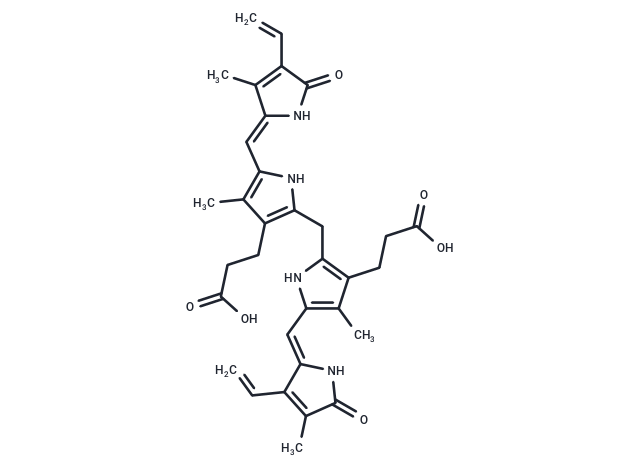Shopping Cart
Remove All Your shopping cart is currently empty
Your shopping cart is currently empty
Bilirubin (Principal bile pigment) is a type of bile pigment, which is a metabolite of hemoglobin in the blood. Bilirubin has antimutagenic and antioxidant effects. Bilirubin is an important basis for clinical determination of jaundice, and is also an important indicator of liver function.

| Pack Size | Price | USA Warehouse | Global Warehouse | Quantity |
|---|---|---|---|---|
| 25 mg | $31 | In Stock | In Stock | |
| 50 mg | $42 | In Stock | In Stock | |
| 100 mg | $59 | In Stock | In Stock | |
| 500 mg | $138 | - | In Stock |
| Description | Bilirubin (Principal bile pigment) is a type of bile pigment, which is a metabolite of hemoglobin in the blood. Bilirubin has antimutagenic and antioxidant effects. Bilirubin is an important basis for clinical determination of jaundice, and is also an important indicator of liver function. |
| In vitro | METHODS: Hippocampal primary neurons were treated with Bilirubin (12-25 µM) for 24 h. Mitochondrial membrane potential (ΔΨm) was measured by JC-1 fluorescence staining.
RESULTS: Bilirubin treatment decreased ΔΨm in a dose-dependent manner. [1] METHODS: Neural stem cell NSC were treated with Bilirubin (6.25-50 µM) for 96 h. Cell viability was measured by MTT assay. RESULTS: Cell viability was significantly reduced after exposure to 50 µM Bilirubin concentration. The viability of cells exposed to Bilirubin was gradually and significantly reduced. [2] |
| In vivo | METHODS: To investigate the effects on atherosclerosis, Bilirubin (30 mg/kg, 50 mmol/L of K3PO4 plus 10% serum) was administered intraperitoneally to Ldlr-/- mice on Western diet once daily for eight weeks.
RESULTS: Bilirubin prevented atherosclerotic plaque formation but did not alter circulating cholesterol or chemokine levels. Bilirubin-treated animals had reduced lipid and collagen deposition in the aortic root, decreased monocyte and lymphocyte infiltration, fewer smooth muscle cells, decreased levels of chlorotyrosine and nitrotyrosine, and no changes in VCAM-1 or ICAM-1 expression. [3] |
| Synonyms | Principal bile pigment, Hemetoidin, Hematoidin, Bilibubin |
| Molecular Weight | 584.66 |
| Formula | C33H36N4O6 |
| Cas No. | 635-65-4 |
| Smiles | C(C1=C(CCC(O)=O)C(C)=C(/C=C\2/C(C=C)=C(C)C(=O)N2)N1)C3=C(CCC(O)=O)C(C)=C(/C=C\4/C(C)=C(C=C)C(=O)N4)N3 |
| Relative Density. | 1.374 g/cm3 |
| Color | Orange |
| Appearance | Solid |
| Storage | store at low temperature,keep away from direct sunlight | Powder: -20°C for 3 years | In solvent: -80°C for 1 year | Shipping with blue ice/Shipping at ambient temperature. | ||||||||||||||||||||
| Solubility Information | DMSO: 9 mg/mL (15.39 mM), Sonication is recommended. | ||||||||||||||||||||
Solution Preparation Table | |||||||||||||||||||||
DMSO
| |||||||||||||||||||||
| Size | Quantity | Unit Price | Amount | Operation |
|---|

Copyright © 2015-2025 TargetMol Chemicals Inc. All Rights Reserved.